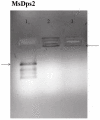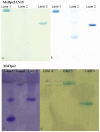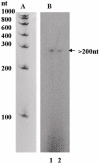The mycobacterial MsDps2 protein is a nucleoid-forming DNA binding protein regulated by sigma factors sigma and sigma
- PMID: 19956571
- PMCID: PMC2779847
- DOI: 10.1371/journal.pone.0008017
The mycobacterial MsDps2 protein is a nucleoid-forming DNA binding protein regulated by sigma factors sigma and sigma
Abstract
The Dps (DNA-binding protein from starved cells) proteins from Mycobacterium smegmatis MsDps1 and MsDps2 are both DNA-binding proteins with some differences. While MsDps1 has two oligomeric states, with one of them responsible for DNA binding, MsDps2 has only one DNA-binding oligomeric state. Both the proteins however, show iron-binding activity. The MsDps1 protein has been shown previously to be induced under conditions of starvation and osmotic stress and is regulated by the extra cellular sigma factors sigma(H) and sigma(F). We show here, that the second Dps homologue in M. smegmatis, namely MsDps2, is purified in a DNA-bound form and exhibits nucleoid-like structures under the atomic force microscope. It appears that the N-terminal sequence of Dps2 plays a role in nucleoid formation. MsDps2, unlike MsDps1, does not show elevated expression in nutritionally starved or stationary phase conditions; rather its promoter is recognized by RNA polymerase containing sigma(A) or sigma(B), under in vitro conditions. We propose that due to the nucleoid-condensing ability, the expression of MsDps2 is tightly regulated inside the cells.
Conflict of interest statement
Figures








Similar articles
-
Structural studies on the second Mycobacterium smegmatis Dps: invariant and variable features of structure, assembly and function.J Mol Biol. 2008 Jan 25;375(4):948-59. doi: 10.1016/j.jmb.2007.10.023. Epub 2007 Oct 16. J Mol Biol. 2008. PMID: 18061613
-
Cryo-EM Reveals the Mechanism of DNA Compaction by Mycobacterium smegmatis Dps2.J Mol Biol. 2024 Nov 1;436(21):168806. doi: 10.1016/j.jmb.2024.168806. Epub 2024 Sep 28. J Mol Biol. 2024. PMID: 39349276 Review.
-
Identification and characterization of the dps promoter of Mycobacterium smegmatis: promoter recognition by stress-specific extracytoplasmic function sigma factors sigmaH and sigmaF.J Bacteriol. 2007 Dec;189(24):8973-81. doi: 10.1128/JB.01222-07. Epub 2007 Oct 5. J Bacteriol. 2007. PMID: 17921287 Free PMC article.
-
Selective repression by Fis and H-NS at the Escherichia coli dps promoter.Mol Microbiol. 2008 Jun;68(6):1366-77. doi: 10.1111/j.1365-2958.2008.06253.x. Epub 2008 Apr 28. Mol Microbiol. 2008. PMID: 18452510
-
Interaction of Escherichia coli sigma 70 with core RNA polymerase.Cold Spring Harb Symp Quant Biol. 1998;63:277-87. doi: 10.1101/sqb.1998.63.277. Cold Spring Harb Symp Quant Biol. 1998. PMID: 10384292 Review. No abstract available.
Cited by
-
The evolution of an osmotically inducible dps in the genus Streptomyces.PLoS One. 2013;8(4):e60772. doi: 10.1371/journal.pone.0060772. Epub 2013 Apr 1. PLoS One. 2013. PMID: 23560105 Free PMC article.
-
Polymorphic Protective Dps-DNA Co-Crystals by Cryo Electron Tomography and Small Angle X-Ray Scattering.Biomolecules. 2019 Dec 26;10(1):39. doi: 10.3390/biom10010039. Biomolecules. 2019. PMID: 31888079 Free PMC article.
-
Type VI Secretion System Transports Zn2+ to Combat Multiple Stresses and Host Immunity.PLoS Pathog. 2015 Jul 2;11(7):e1005020. doi: 10.1371/journal.ppat.1005020. eCollection 2015 Jul. PLoS Pathog. 2015. PMID: 26134274 Free PMC article.
-
Manganese scavenging and oxidative stress response mediated by type VI secretion system in Burkholderia thailandensis.Proc Natl Acad Sci U S A. 2017 Mar 14;114(11):E2233-E2242. doi: 10.1073/pnas.1614902114. Epub 2017 Feb 27. Proc Natl Acad Sci U S A. 2017. PMID: 28242693 Free PMC article.
-
The nucleoid protein Dps binds genomic DNA of Escherichia coli in a non-random manner.PLoS One. 2017 Aug 11;12(8):e0182800. doi: 10.1371/journal.pone.0182800. eCollection 2017. PLoS One. 2017. PMID: 28800583 Free PMC article.
References
-
- Matin A, Auger EA, Blum PH, Schultz JE. Genetic basis of starvation survival in non differentiating bacteria. Annu Rev Microbiol. 1989;43:293–316. - PubMed
-
- Frenkiel-Krispin D, Minsky A. Nucleoid organization and the maintenance of DNA integrity in E. coli, B. subtilis and D. radiodurans. J Struct Biol. 2006;156:311–319. - PubMed
-
- Almirón M, Link AJ, Furlong D, Kolter R. A novel DNA-binding protein with regulatory and protective roles in starved Escherichia coli. Genes Dev. 1992;6:2646–2654. - PubMed
-
- Gupta S, Pandit SB, Srinivasan N, Chatterji D. Proteomics analysis of carbon-starved Mycobacterium smegmatis: induction of Dps-like protein. Protein Eng. 2002;15:503–512. - PubMed
Publication types
MeSH terms
Substances
LinkOut - more resources
Full Text Sources

